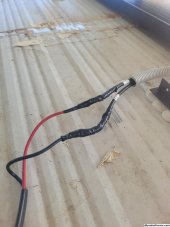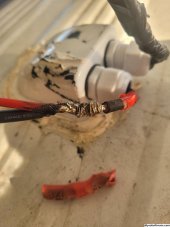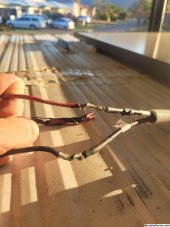Hi guys,
Recently I posted a thread trying to figure out some issues I've been having with my solar set up. The thread can be found here.
I decided to inspect the panels and their connection, and I have to say I'm not particularly impressed. I'm seeking feedback from the community as to what my next moves should be.




It looks like they've used a blow torch to solder the panels in series, then torched some shrink wrap around it. Wrapped it up in electrical tape for good measure. My first thought is that the charring on the shrink wrap and able ends is due to excessive external heat, rather than overheating due to a short, but its hard to say.
I think we can safely say that this is not the proper way to connect solar cables, nor is it a technique I should be charged ~$450USD (inc cables and fusing (lol)) for.
Is this explicitly the cause of my issues? Not sure.
Would rewiring the panels with Y connectors fix the issue? Probably.
Did they complete the job they were assigned? Yes.
Is this quality workmanship? No.
Negligent? ?
The job was done at a shop some 16hrs away from my current location, so I won't be asking them to redo it. Should I request a refund for the installation fee? Fee and panels? High Court of Australia?
Recently I posted a thread trying to figure out some issues I've been having with my solar set up. The thread can be found here.
I decided to inspect the panels and their connection, and I have to say I'm not particularly impressed. I'm seeking feedback from the community as to what my next moves should be.



It looks like they've used a blow torch to solder the panels in series, then torched some shrink wrap around it. Wrapped it up in electrical tape for good measure. My first thought is that the charring on the shrink wrap and able ends is due to excessive external heat, rather than overheating due to a short, but its hard to say.
I think we can safely say that this is not the proper way to connect solar cables, nor is it a technique I should be charged ~$450USD (inc cables and fusing (lol)) for.
Is this explicitly the cause of my issues? Not sure.
Would rewiring the panels with Y connectors fix the issue? Probably.
Did they complete the job they were assigned? Yes.
Is this quality workmanship? No.
Negligent? ?
The job was done at a shop some 16hrs away from my current location, so I won't be asking them to redo it. Should I request a refund for the installation fee? Fee and panels? High Court of Australia?




